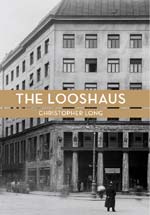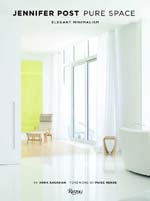
|

|
|
Home Site Search Contact Us Subscribe
|
|
|
Book Review: Tracing a Hidden Track from Adolf Loos as Modernist Architect to Jennifer Post as Modernist Interior Designer By considering this unlikely couple, we can air out that beleaguered term "architectural minimalism" and trace a trajectory of what might be better identified as "essentialist architecture." By Norman Weinstein March 2, 2012 There’s something terribly slippery about the term “Minimalism,” so much so that Robert Venturi had an irresistible riposte with his “Less is a Bore” when the Miesian “Less is More” was losing authority in the 1960s. Any architectural action is, however miniscule, an extravagant assertion that articulated spatial interventions add significant meaning to our mundane experiences. So when “Minimalism” first entered the vocabulary of the art world through reviews of installation artists Robert Morris and Dan Flavin, we were confronted with the word signifying primarily starkly geometric sculptural forms communicating radical simplicity with clean, sharply-etched edges. “Minimalism” wasn’t used to categorize architecture circa 1965. Yet a considerable body of Ludwig Mies van der Rohe’s designs surely shared the primal geometric vigor and clean edges identified with minimalist sculpture – but Mies represented the essence of “Modernism,” not “Minimalism,” a concept apparently subsumed by it.
My anything-but-minimalist opening paragraph sets you up for praises bestowed on two apparently disconnected, but exceptionally well written and illustrated books, The Looshaus (Yale University Press, 2011) by architectural historian Christopher Long, and Jennifer Post: Pure Space: Elegant Minimalism (Rizzoli, 2012) by Anna Kasabian. Long’s affectionate and scrupulously detailed tribute to an easily overlooked building puts it in the spotlight it has long deserved in architectural history. Kasabian’s coffee table book is more probing than much on contemporary interiors. There’s a powerful link connecting a study of the century-old Viennese architect’s most iconic building and a highly acclaimed interior designer of the rich and famous in our time. By considering this unlikely couple, we can air out that beleaguered term “architectural minimalism” and trace a trajectory of what might be better identified as “essentialist architecture.”
Adolf Loos is best remembered by today’s architects, when remembered at all, for his polemical assertion at the start of the 20th century that architectural ornamentation was tantamount to criminal action. In an extraordinarily fine-grained historic study of the creation of the Goldman & Salatsch Building in Vienna, known as “The Looshaus,” Christopher Long adds depth and complexity to how Loos thought about space and ornamentation. Long demonstrates that Loos was not monolithically opposed to all ornamentation. He was designing to define a sense of modernity in which most superfluous elements would be absent, affirming modern architecture as that which would reconnect contemporary design with the crafted distinction of traditional European vernacular architecture. Credit Loos with mining the obscure “folk roots” of the Modernist revolution. Wiping away baroquely festooned façades as antiquarian and purposeless, Loos designed the Goldman & Salatsch building as a “mixed use” building at the heart of old Vienna’s downtown. The bottom floor was created for a fine men’s tailoring and outfitting store; the remaining four floors were dedicated to apartments. Virulent public criticism was aimed at Loos for the overwhelming plainness of the façade for the upper floors. It is unimaginable to think of a new urban building in 2012 anywhere causing this kind of riot, much in the style of the audience response to the première of Igor Stravinsky’s “The Rite of Spring” during the same era.
What in 2012 we see as a moderately austere and calmly handsome building was viewed in the first decade of the 20th century as a massive affront to sensible architectural taste. The façade’s bareness triggered public and editorial venom. Loos faced accusations of creating a “grain elevator” or “Die Mistkiste” (which Long tactfully translates as “dung crate” and I’ll translate as “shit house”), all of which led the architect to a nervous collapse with bleeding ulcers. But more was at stake than the building’s bare façade. The deep-set windows of the residential stories were purposefully not in alignment with the store fenestration at ground level. Also significantly, Loos, an architect with ears extraordinarily attuned to the music of his contemporaries Mahler and Schoenberg, created stark rhythmic accents both through fenestration patterns and the harmonious orchestration of rooms of significantly different heights.
All of these innovations in “The Looshaus” marked the birth of a Grail-quest for the absolute, irreducible, and essential architecturally within Modernism. With his Tuscan columns and fine marble finishes at the ground floor, Loos wasn’t a fanatically “pure” practitioner of the essential. While damning the outrageously ornamental, Loos had a connoisseur’s taste for fine wood and metallic touches that was simply exquisitely refined. As exquisite for their time and place as Mies’s affection for a skyscraper’s coppery sheen catching New York’s sunlight was for his. How fitting was the fact that the first floor of the Looshaus was a tailoring store. It was, and is, a “well tailored” building, fit and fitting, trim, formally austere yet inviting to the public. In mythic terms, welcome to Apollo’s architecture, the god of music who performs no superfluous notes.
Advance a century and meet the inheritor of the Loosian sensibility. Jennifer Post is to interior design today what Richard Meier is to architecture: an obsessive poetic lyricist of whiteness. That said, since that is so obviously her surface stylistic signature, with retina-rattling whites tamed by earth tones and dark wood assertions, I’d like to propose that she’s the capstone of the kind of “thinking in space” that Loos pioneered. Using (like Loos) a greatly limited range of materials and colors, Post specializes in creating supremely modern interiors where cluttered ornamentation is verboten, and a stark essential environment prevails, formal yet seductive (again like Loos, exquisitely tailored). The essence of modernity for Post is an interior where necessary human desires are welcome and cultivated in a highly refined fashion. Post perceives practicing yoga as integral to her designing, and that unadorned system of rehearsing primly primal anatomical moves might have been endorsed by Loos as a cure for his chronic ulcers. With Loos’s love of exotic woods and brilliant metal fixtures counterpointed by white walls bereft of ornamentation, Post creates light-filled interiors of stately Apollonian calm, washed in an otherworldly glow. The art of Adolf Loos and Jennifer Post can be labeled “Modernism,” or by its critics “Plain Vanilla Modernism,” but they share a practice confirming simplicity is never simply attained in design. Simplicity is earned through the intellectual yoga of sharply differentiating the essential from the superfluous moment by moment, inch by inch.
Norman Weinstein writes about architecture and design for Architectural Record, and is the author of “Words That Build” – an exclusive 21-part series published by ArchNewsNow.com – that focuses on the overlooked foundations of architecture: oral and written communication. He consults with architects and engineers interested in communicating more profitably; his webinars are available from ExecSense. He can be reached at nweinstein@q.com.
More by Weinstein:
A Meditation on the Beauty of Zaha Hadid's Door Handle Hadid's design issues a challenge: define beauty by lyrically playing with illusion.
Why
"Greatest Hits" Lists by Architecture's Stars Should Be Mocked
Celebratory Meditations on SANAA Winning the Pritzker Prize
Op-Ed: Life After Ada: Reassessing the Utility of
Architectural Criticism
Two Books to
Accelerate the Translation of Ideas into Practical Forms
Book Review: How to
be a Useful Architectural Critic: Alexandra Lange's Perspicacious Primer Points
the Way
Michael Sorkin: Architectural
Critic as Scam Scanner and Urban(e) Design Sage
Best Architecture
Books of 2011
Book
Review: Pencils that Refuse to Die: Meditations about New Books on
Architectural Drawing
Book
Review: "One Million Acres & No Zoning": Lars Lerup's Outrageous
Encomium to Houston Instructs and Infuriates
Book
Review: Talkin' 'Bout (Not) My Generation: Uplifting Gen X Architects Showcase
Pragmatic Optimism
"Frank
Lloyd Wright's Guggenheim Museum": Bravura Example of an Architectural
Documentary - Wright's Guggenheim Done Right
Book
Review: Diving into Architecture from Every New Angle: Reading Guillevic's
"Geometries"
Book
Review: "Immaterial World: Transparency in Architecture": Marc
Kristal crystallizes increasingly complex notions of transparency with a light
touch.
Book
Review: "Visual Planning and the Picuresque" by Nikolaus Pevsner.
Edited by Mathew Aitchison
Book
Review: How New Urbanism's Case Triumphs Best Through "The Language of
Towns & Cities: A Visual Dictionary" by Dhiru A. Thadani
Best
Architecture Books of 2010
Book Review:
"Architecture and Beauty: Conversations with Architects about a Troubled
Relationship": Yael Reisner exuberantly interviews architects about beauty
Book
Review: Shedding Light on Concrete: Tadao Ando: Complete Works 1975-2010 by
Philip Jodidio
Book
Review: Sage Architectural Reflections from Architecture's "Athena":
Denise Scott Brown's "Having Words" distills a lifetime of theorizing
and practice into practical and succinct guidance for thriving through
difficult times
Book Review:
Keeping the Architectural Profession Professional: "Architecture from the
Outside In: Selected Essays by Robert Gutman" celebrates Gutman's legacy
as invaluable outsider
Book
Review: "Design through Dialogue: A Guide for Clients and
Architects," by Karen A. Franck and Teresa von Sommaruga Howard
Twilight Visions: Vintage Surrealist Photography Sheds
New Light on Architecture
Best
Architecture Books of 2009
Book Review: "Gunnar Birkerts: Metaphoric Modernist" by Sven Birkerts and Martin Schwartz A major architect in the history of Modernism finally receives recognition – and sundry asides about why Modernism never exited.
Book Review:
"Urban Design for an Urban Century: Placemaking for People," by Lance
Jay Brown, David Dixon, and Oliver Gillham
Book Review:
"Everything Must Move: 15 Years at Rice School of Architecture
1994-2009"
Book Review: A Subversive Book Every Architect Needs:
"Architect's Essentials of Negotiation" by Ava J. Abramowitz
Book Review: A Perspective from One Elevation: "Conversations With Frank Gehry" by Barbara Isenberg Gehry's conversations offer portraits of an astute listener as well as talker, an architect as aware of his flaws and limitations as of his virtues.
Best Architecture Books of 2008
Book Review: You've Got to Draw the Line Somewhere A review of Drafting Culture: a Social History of Architectural Graphic Standards by George Barnett Johnston
Book Review: "NeoHooDoo: Art for a Forgotten Faith," edited by F
|
(click on pictures to enlarge) 

|
© 2012 ArchNewsNow.com